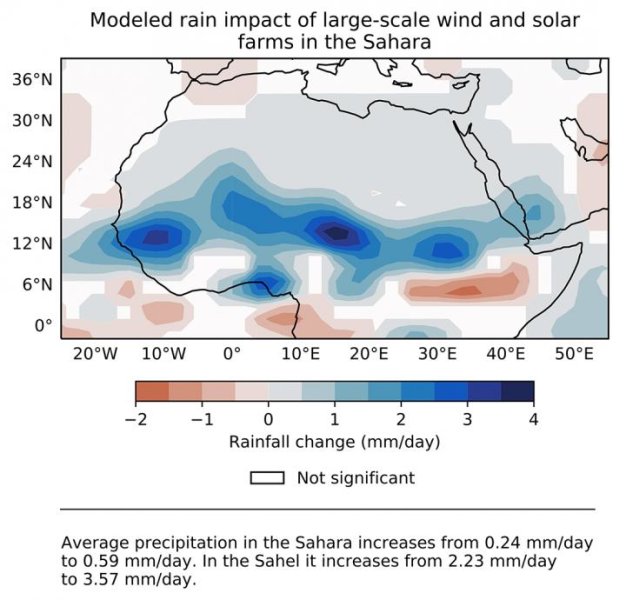Image: Jgremillot
The Sahara Desert is a dream location for renewable energy industries. The same qualities that make this region so legendary—searing Sun exposure, blustering gales, sparse populations—also distinguish it as an obvious place to develop wind and solar farms. Many ambitious green energy projects are already underway in the desert, including the Sahara Solar Breeder Project, which aims to power half the world from the desert by 2050.While the Sahara’s potential as a global energy hub has long been recognized, the impacts of such development on the desert environment itself have been mostly overlooked. A team led by Yan Li, a postdoctoral researcher in natural resources and environmental sciences at the University of Illinois, bridges this gap in the latest issue of Science.The team developed climate models of the temperature, precipitation, and vegetation changes that would result from blanketing the full 9 million square kilometers (3,500,000 square miles) of the Sahara's surface area, in solar and wind farms.Li and his colleagues found that such a large-scale project would generate over four times the amount of electricity as the entire 2017 global energy budget. But the team also noted that green mega-projects would benefit the region itself by boosting local temperatures, precipitation, and vegetation levels around the farms. “Our results obtained from experiments performed with a climate model suggest that, for installations of wind and solar farms with current conversion efficiency in the desert at a scale large enough to power the entire world, the impacts on regional climate would be beneficial rather than detrimental,” the authors concluded. “This highlights that, in addition to avoiding anthropogenic greenhouse gas emissions from fossil fuels and the resulting warming, wind and solar energy could have other unexpected beneficial climate impacts.”In the case of wind farms, the temperature and precipitation spikes are caused by turbine blades tugging warmer air down to the desert surface. Solar farms, meanwhile, make regions hotter and wetter by reducing surface albedo, or reflectiveness. Combined, these farms would spark a twofold increase in rainfall, which in turn would stimulate vegetation growth, creating a positive feedback loop that could irrigate this notoriously arid region.
“Our results obtained from experiments performed with a climate model suggest that, for installations of wind and solar farms with current conversion efficiency in the desert at a scale large enough to power the entire world, the impacts on regional climate would be beneficial rather than detrimental,” the authors concluded. “This highlights that, in addition to avoiding anthropogenic greenhouse gas emissions from fossil fuels and the resulting warming, wind and solar energy could have other unexpected beneficial climate impacts.”In the case of wind farms, the temperature and precipitation spikes are caused by turbine blades tugging warmer air down to the desert surface. Solar farms, meanwhile, make regions hotter and wetter by reducing surface albedo, or reflectiveness. Combined, these farms would spark a twofold increase in rainfall, which in turn would stimulate vegetation growth, creating a positive feedback loop that could irrigate this notoriously arid region.
Advertisement

Advertisement
For now, these scenarios are just simulations, and any large development like the one envisioned by Li’s team would have to account for numerous contingencies before ever getting to the construction phrase. But a future in which the Sahara Desert goes green, in more ways than one, is still a tantalizing possibility.Correction: A previous version of this article stated that 9 million square kilometers was 0.1% of the Sahara's surface area. That figure is its full surface area. Motherboard regrets the error.Get six of our favorite Motherboard stories every day by signing up for our newsletter.
